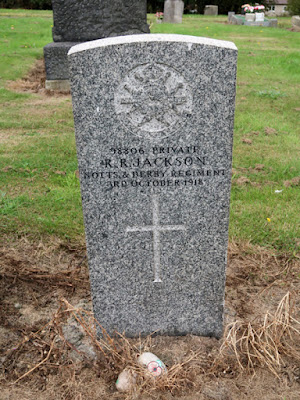 |
| Inver granite used for the headstone of L. Dickinson |
Inbetween undertaking a recce and leading the Sheffield U3A Geology Group on their field trip to the Clowne Greenway and Markland Grips, I spent a couple of hourson a Sunday afternoon in nearby Woodhouse, to further explore its historic buildings.
Starting at Woodhouse Cemetery, to photograph the gateway, lodge and chapel for the British Listed Buildings website, I was interested to discover during subsequent research that these were built in 1878 to the design of the architects Innocent and Brown, who were responsible for very many of the Sheffield Board Schools that I had been surveying for the last nine months.
The dressings are all made of pale cream oolitic limestone from the Jurassic Lincolnshire Limestone Formation, very probably Ancaster stone, but the walling stone is well bedded Coal Measures sandstone, which contains siltstone beds that are differentially weathered.
Quite often, architects favour particular types of stones in their projects, with CJ Innocent making extensive use of the medium grained, well bedded Crawshaw Sandstone for the Sheffield Board Schools, which was extensively quarried at Bole Hill in Crookes and Walkley; however, the stone used in these is uniformly buff coloured and, almost without exception, is still in good condition.
While at the cemetery, I investigated the Commonwealth War Graves Commission (CWG) headstones to see if I could find any new regimental crests. I was interested to see a memorial commemorating both Serjeant J. Gavins and Private F. Gavins of the Durham Light Infantry and Northumberland Fusiliers respectively, which is made in a granite that I had seen at Crookes Cemetery and Abbey Lane Cemetery – possibly the French Vire Blanc or Glenaby granite.
The headstone of Private R.R. Jackson of the Sherwood Foresters (Notts and Derby Regiment) is made out of similar granite but, as with the above memorial, it is very difficult to see and photograph the details of the regimental crest.
The headstones of Private C.H. Clarke of the Duke of Wellington’s Regiment and Gunner L. Smith of the 97 (The Kent Yeomanry) Field Regiment are made in Portland limestone, which is the stone most commonly used by the CWG.
Although the regimental crest of the Royal Artillery on the headstone to Driver L. Dickinson is now familiar to me, it was the first time that I had encountered Inver granite from Crathie in Aberdeenshire, which once supplied stone for the Balmoral Estate. This granite differs from the other granites in the cemetery in that it has feldspars that are both white and light pink in colour.
Leaving Woodhouse Cemetery, I headed back towards the centre of Woodhouse and on to Beighton Road, where I photographed the Grade II Listed No. 53 and its gateposts, c. 1830, which I assume is built using the local Pennine Middle Coal Measures Formation sandstone that was formerly known as the Woodhouse Rock.
Along Beighton Road, there are various houses built in a similar light brown, massive cross bedded sandstone, which is iron stained to varying degrees. None of these buildings are listed and it is therefore assumed that the cheapest local stone has also been used to build these.
Making my way along Beighton Road, I finished my short investigation of the building stones of Woodhouse by taking a very quick look at the former Woodhouse East Board School, which at the time of my visit was being converted into apartments.
The Sheffield architect, J.D. Webster was commissioned by the Handsworth School Board for this and two other board schools and it was completed in 1899. In style, it is very plain with a symmetrical front elevation, projecting wings at each end and gables that contain tall triple light windows, a band course and are topped with a simple finial.
I couldn’t get close enough to take a good look at the sandstone used for the walling but, even when dirty, it doesn’t look like Crawshaw Sandstone to me, although the dressings are probably medium grained massive Stoke Hall sandstone from Derbyshire, which has been used in very many of the Sheffield Board Schools.













No comments:
Post a Comment